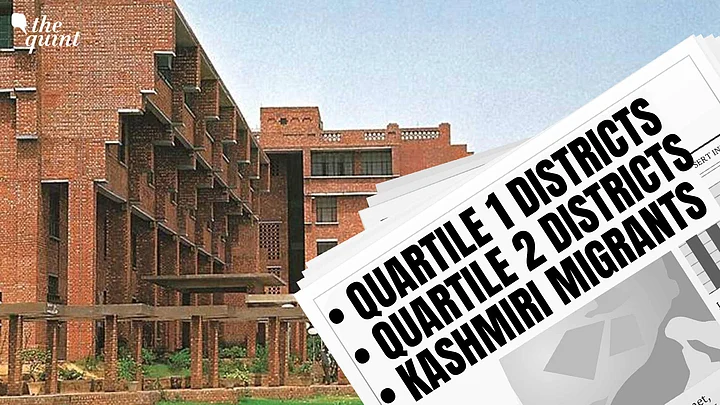On 10 July, Santishree Dhulipudi Pandit, the Vice-Chancellor of Jawaharlal Nehru University (JNU) in Delhi, announced that the “Deprivation Points” model will be reintroduced for research degree admissions. This has been a long-standing demand of teachers and students, who believe that it is key to ensuring equity in the admission process.
The unique model was discontinued in 2017 for research degree admissions by the then-VC, Jagadesh Kumar Mamidala.
But what are “deprivation points?” How are they calculated? Why are they important? The Quint spoke to JNU professors in search of all these answers.
What are Deprivation Points?
This model classifies districts in the country in terms of quartiles. The quartiles are based on a range of development criteria such as percentage of rural population and percentage of illiteracy among females. They have been identified by the University on the basis of the 2001 Census from each state in the form of quartile 1 and quartile 2 districts. For instance, Mewat in Haryana, Bhagalpur in Bihar, Jhabua in Madhya Pradesh and Purulia in West Bengal are identified as quartile 1 districts.
In addition to these, Kashmiri migrants are awarded five points and women candidates are awarded five points. Wards or widows of defence personnel who were killed in action are also awarded five points.
These points are added to the marks obtained by students in the written exam and the viva exam.
In 2017, the model was discontinued for research admissions but it continued for Bachelor’s and Master’s programmes. Sucharita Sen, JNU professor, told The Quint, “JNU offers a niche education system that includes students from all walks of life, and deprivation points have been a big catalyst in achieving this.”
Ayesha Kidwai, Professor at the Centre for Linguistics and School of Language Literature and Culture Studies, said;
Once the exams are complete, students are given deprivation points. Hence, if someone from a backward region is in the shooting range of securing admission, it might help them secure admission. The system acknowledges that the candidate has fought adversity of some sort.Ayesha Kidwai, JNU professor
History of the “Deprivation Points” Model in JNU
Kidwai told The Quint that deprivation points had been introduced in 1973 after a proposal submitted by the JNU Students’ Union. For 10 years, the University followed a 20-point model, based on socio-economic and regional backwardness. It was withdrawn in 1984 and then reintroduced in 1994.
The new system, which came in the wake of the Mandal Commission Report, capped the number of deprivation points at 10, recognised Other Backward Class (OBC) certificates and female gender as the basis of deprivation points, alongside regional deprivation.
Over the years, the structure evolved to become what it is today. When it was scrapped for research programmes, it drew harsh criticism from teachers and students alike.
‘They Are Important to Maintain Equity and Diversity’
Bikramaditya Kumar Choudhary, who teaches at the Centre for the Study of Regional Development, said that "the system is important to ensure that students from all backgrounds are given a chance to study at the University."
When the model had been done away with, it led to a change in the demographic. Professor Sen said, “Earlier, 25 percent of the students fell under lowest-income category i.e. a household income of Rs 6,000 per month. But this has reduced to 9.3 percent, of late. This is because many regional areas have a high incidence of poverty. So when regional deprivation points are removed, the poorest students are left out of the ambit.”
When we say that we learn from students, we that we have such a diverse set of students that we are able to see certain things that we might have not been able to. It is also beneficial for students who come from privileged backgrounds as it can be an eye-opener for them.Bikramaditya Kumar Choudhary, JNU Professor
It is also a way of ensuring that admissions go beyond academics. Many professors say that it also impacts the quality of research produced by the University.
According to Professor Sen, deprivation points ensure equity but also have a bearing on the kind of research done by the University. She said, “This is because the researcher’s life trajectory has a bearing on the kind of research as well as the sensitivity with which research is conducted.”
She said that when students from all backgrounds are admitted to the University, the research ends up being more diverse in nature.
On one hand, it does ensure that students from all backgrounds are admitted but it is also important because of the way that they can contribute to the country.Sucharita Sen, JNU professor
Emphasising this with an example, Kidwai, who teaches in the Centre for Linguistics, said, “For instance, there is a chance that lesser spoken languages, which are generally not studied, are studied if there is a student hailing from backward regions.”
Some professors said that no new model has been designed yet. It is unsure if a new model will be designed or whether the old model will be considered.
